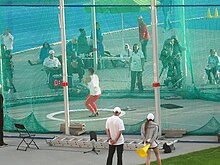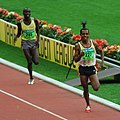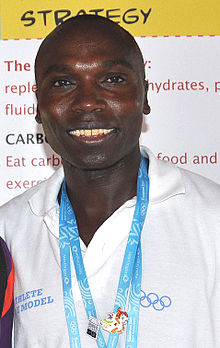Portal:Sport of athletics
Introduction

Athletics is a group of sporting events that involves competitive running, jumping, throwing, and walking. The most common types of athletics competitions are track and field, road running, cross-country running, and racewalking.
The results of racing events are decided by finishing position (or time, where measured), while the jumps and throws are won by the athlete that achieves the highest or furthest measurement from a series of attempts. The simplicity of the competitions, and the lack of a need for expensive equipment, makes athletics one of the most common types of sports in the world. Athletics is mostly an individual sport, with the exception of relay races and competitions which combine athletes' performances for a team score, such as cross country.
Organized athletics are traced back to the Ancient Olympic Games from 776 BC. The rules and format of the modern events in athletics were defined in Western Europe and North America in the 19th and early 20th century, and were then spread to other parts of the world. Most modern top level meetings are held under the auspices of World Athletics, the global governing body for the sport of athletics, or its member continental and national federations. (Full article...)
General images -
Selected article

The hammer throw is one of the four throwing events in regular outdoor track and field competitions, along with the discus throw, shot put and javelin.
The "hammer" used in this sport is not like any of the tools also called by that name. It consists of a metal ball attached by a steel wire to a grip. These three components are each separate and can move independently. Both the size and weight of the ball vary between men's and women's events. The women's hammer weighs 4 kilograms (8.8 lb) for college and professional meets while the men's hammer weighs 7.26 kilograms (16.0 lb). (Full article...)
The men's hammer weighs 16 pounds (7.26 kg) and measures 3 feet 11+3⁄4 inches (121.3 cm) in length, and the women's hammer weighs 4 kg (8.82 lb) and 3 ft 11 in (119.4 cm) in length.[1] Like the other throwing events, the competition is decided by who can throw the implement the farthest.
The throwing motion starts with the thrower swinging the hammer back-and-forth about two times to generate momentum. The thrower then makes three, four or (rarely) five full rotations using a complex heel-toe foot movement, spinning the hammer in a circular path and increasing its angular velocity with each rotation. Rather than spinning the hammer horizontally, it is instead spun in a plane that angles up towards the direction in which it will be launched. The thrower releases the hammer as its velocity is upward and toward the target.[2]

Throws are made from a throwing circle. The thrower is not allowed to step outside the throwing circle before the hammer has landed and may only enter and exit from the rear of the throwing circle. The hammer must land within a 34.92º throwing sector that is centered on the throwing circle. The sector angle was chosen because it provides a sector whose bounds are easy to measure and lay out on a field (10 metres out from the center of the ring, 6 metres across).[3][4] A violation of the rules results in a foul and the throw not being counted.[citation needed]
| More selected articles |
Selected picture

Athlete birthdays
12 May:
- Andrew Howe, Italian long jumper
- Henry Jonsson, Swedish distance runner
- Igor Kováč, Slovakian hurdler
- Liu Hong, Chinese race walker
- Lisa Martin, Australian distance runner
- Renate Stecher, German sprinter
13 May:
- Hildrun Claus, German long jumper
- Peter Frenkel, German race walker
- Dawn Harper-Nelson, American hurdler
- Amine Laâlou, Moroccan middle-distance runner
- Dmitriy Shevchenko, Russian discus thrower
- Kokichi Tsuburaya, Japanese distance runner
14 May:
- Kenth Eldebrink, Swedish javelin thrower
- Fred Englehardt, American triple jumper
- Natasha Kaiser-Brown, American sprinter
- Godfrey Rampling, British sprinter
- Alina Talay, Belarusian hurdler
15 May:
- Don Bragg, American pole vaulter
- Daniel Caines, British sprinter
- Veronica Campbell-Brown, Jamaican sprinter
- Valentina Gerasimova, Soviet middle-distance runner
- Li Yanfeng, Chinese discus thrower
- Fred Murray, American hurdler
- Justine Robbeson, South African javelin thrower
- Miruts Yifter, Ethiopian distance runner
16 May:
- Joan Benoit Samuelson, American distance runner
- Irina Korzhanenko, Russian shot putter
- Steve Lewis, American sprinter
- Albina Mayorova, Russian distance runner
- Helga Radtke, German long jumper
- Bob Tisdall, Irish hurdler and decathlete
17 May:
- Yelena Gorchakova, Russian javelin thrower
- Daniel Komen, Kenyan distance runner
- Mayte Martínez, Spanish middle-distance runner
- Christine Ohuruogu, British sprinter
- Gilles Quénéhervé, French sprinter
- William Yiampoy, Kenyan middle-distance runner
18 May:
- Eric Backman, Swedish distance runner
- Denis Horgan, Irish thrower
- Charles Kamathi, Kenyan distance runner
- Ivet Lalova, Bulgarian sprinter
- Renata Nielsen, Danish long jumper
- Volha Tsander, Belarusian hammer thrower
- Angela Voigt, German long jumper
Related portals
More did you know
- ... that 1985 NCAA hurdling champion Thomas Wilcher won the Michigan High School Athletic Association team track & field championship three consecutive times, both as an athlete and a coach?
- ... that Charlie Fonville broke a 14-year-old shot put world record by almost twelve inches at the 1948 Kansas Relays but was not allowed to stay with the other athletes because he was African-American?
- ... that the Peachtree Road Race, held annually on July 4 (U.S. Independence Day) in Atlanta, Georgia, is the world's largest 10 kilometer road race with 55,000 runners participating in 2007?
- ... that Patrick Ivuti's photo finish victory in the 2007 Chicago Marathon, one of the five major marathons, was his first marathon victory?
| Archive |
Selected biography
Wilson Kosgei Kipketer (born 12 December 1972) is a Danish former middle distance runner. He is the second fastest of all time over 800 meters, setting the world record and breaking his own record two more times all in 1997. He dominated the 800 m distance for a decade, remaining undefeated for a three-year period and running 8 of the 17 currently all-time fastest times. He won gold medals in three successive editions of the IAAF World Championships in Athletics. Though unable to compete in the 1996 Olympics near the peak of his career, he earned silver in 2000 and bronze in 2004. Kipketer's 800 meters world record stood for almost 13 years. It was surpassed on 22 August 2010, when David Rudisha beat it by 0.02 seconds, running 1:41.09. Rudisha would eventually go on to further lower the 800m world record to the first and only sub one minute 41 second run. Kipketer still currently holds the indoor world record for the 800 metres.
Kipketer represented both Sparta and KIF during his running career. (Full article...)
| More selected biographies |
Did you know (auto-generated) -

- ... that at the 2022 British Indoor Athletics Championships, Lorraine Ugen equalled the championship long jump record?
- ... that German runner Alica Schmidt, who is running in the Women's 4 × 400 metres relay at the 2020 Summer Olympics, has won multiple European junior relay medals?
- ... that the women's race at today's New York City Marathon will feature two of the medalists from this year's Olympic marathon?
- ... that Marthe Yankurije, who dropped out of school during her fourth year of secondary school, competed at the 2020 Summer Olympics?
- ... that the men's 100 metres event at the 2023 British Athletics Championships was run in heavy rain?
- ... that at the 2022 British Athletics Championships, Daryll Neita became the first woman since 2010 to win both the 100- and 200-metre events?
- ... that for the first time this century, this year's British Athletics Championships were not broadcast on live television?
- ... that in the 1932 baseball game in which pitcher Eddie Rommel won his last game, he pitched 17 innings in relief, an American League record?
World records
| Event | Men | Record | Women | Record |
|---|---|---|---|---|
| 100 m | 9.58 | 10.49 | ||
| 200 m | 19.19 | 21.34 | ||
| 400 m | 43.03 | 47.60 | ||
| 800 m | 1:40.91 | 1:53.28 | ||
| 1500 m | 3:26.00 | 3:49.11 | ||
| 5000 m | 12:35.36 | 14:00.21 | ||
| 10,000 m | 26:11.00 | 29:01.03 | ||
| Marathon | 2:00:35 | 2:14:04 | ||
| 3000 m steeplechase | 7:52.11 | 8:44.32 | ||
| 110 / 100 m hurdles | 12.80 | 12.12 | ||
| 400 m hurdles | 45.94 | 50.68 | ||
| High jump | 2.45 m | 2.09 m | ||
| Pole vault | 6.23 m | 5.06 m | ||
| Long jump | 8.95 m | 7.52 m | ||
| Triple jump | 18.29 m | 15.74 m | ||
| Shot put | 23.56 m | 22.63 m | ||
| Discus throw | 74.08 m | 76.80 m | ||
| Hammer throw | 86.74 m | 82.98 m | ||
| Javelin throw | 98.48 m | 72.28 m | ||
| Decathlon/Heptathlon | 9126 pts. | 7291 pts. | ||
| 20 km racewalk | 1:16:36 | 1:23:49 | ||
| 4×100 m relay | 36.84 | 40.82 | ||
| 4×400 m relay | 2:54.29 | 3:15.17 |
Topics
Athletics events
|
|
|
|
|
Athletics competitions
It's from the first edition (1896 Summer Olympics), that Athletics has been considered the "Queen" of the Olympics. Since then there have been a series of competitions organized at world level, than at the continental level. Furthermore, the Athletics is the main sport of nearly all multi-sport events such as Universiade, Mediterranean Games or Pan American Games. The following list refers to the main Athletics competitions that take place in the world.
| Event | 1st edition | Kind of competition | Can participate |
|---|---|---|---|
| Olympic Games | 1896 | World games | |
| World Championships | 1983 | World championships | |
| World Indoor Championships | 1985 | ||
| European Championships | 1934 | Continental championships | |
| European Indoor Championships | 1966 | ||
| South American Championships | 1919 | ||
| Asian Championships | 1973 | ||
| African Championships | 1979 | ||
| Ocenian Championships | 1990 |
Federations
- Internationals
 International Association of Athletics Federations (IAAF)
International Association of Athletics Federations (IAAF) European Athletics Association (EAA)
European Athletics Association (EAA) Confederation of African Athletics (CAA)
Confederation of African Athletics (CAA) Asian Athletics Association (AAA)
Asian Athletics Association (AAA) North American, Central American and Caribbean Athletic Association
North American, Central American and Caribbean Athletic Association CONSUDATLE
CONSUDATLE Oceania Athletics Association (OAA)
Oceania Athletics Association (OAA)
- Nationals
 Australia: Athletics Australia (AA)
Australia: Athletics Australia (AA) Brazil: Brazilian Athletics Confederation (CBAt)
Brazil: Brazilian Athletics Confederation (CBAt) Canada: Athletics Canada (AC)
Canada: Athletics Canada (AC) Czech: Czech Athletics Federation (ČAS)
Czech: Czech Athletics Federation (ČAS) France: Fédération française d'athlétisme (FFA)
France: Fédération française d'athlétisme (FFA) Germany: German Athletics Association (DLV)
Germany: German Athletics Association (DLV) Italy: Italian Athletics Federation (FIDAL)
Italy: Italian Athletics Federation (FIDAL) Jamaica: Jamaica Athletics Administrative Association (JAAA)
Jamaica: Jamaica Athletics Administrative Association (JAAA) Japan: Japan Association of Athletics Federations (JAAF)
Japan: Japan Association of Athletics Federations (JAAF) Kenya: Athletics Kenya (AK)
Kenya: Athletics Kenya (AK) China: Chinese Athletic Association
China: Chinese Athletic Association Norway: Norwegian Athletics Association
Norway: Norwegian Athletics Association Romania: Romanian Athletics Federation
Romania: Romanian Athletics Federation Spain: Royal Spanish Athletics Federation (RFEA)
Spain: Royal Spanish Athletics Federation (RFEA) Great Britain: UK Athletics (UKA)
Great Britain: UK Athletics (UKA) United States: USA Track & Field (USATF)
United States: USA Track & Field (USATF)
- Others
 Wales: Welsh Athletics (WA)
Wales: Welsh Athletics (WA) England: Amateur Athletic Association of England (AAA)
England: Amateur Athletic Association of England (AAA) Scotland: Scottishathletics
Scotland: Scottishathletics Athletic Association of Small States of Europe (AASSE)
Athletic Association of Small States of Europe (AASSE)
Categories
Associated Wikimedia
The following Wikimedia Foundation sister projects provide more on this subject:
-
Commons
Free media repository -
Wikibooks
Free textbooks and manuals -
Wikidata
Free knowledge base -
Wikinews
Free-content news -
Wikiquote
Collection of quotations -
Wikisource
Free-content library -
Wikiversity
Free learning tools -
Wiktionary
Dictionary and thesaurus
Sources
- ^ "Hammer Throw". World Athletics. Archived from the original on November 19, 2021. Retrieved May 12, 2022.
- ^ Johannsen, Dana (1 August 2021). "Tokyo 2020: Why the Olympic hammer throw may become a new national obsession". Stuff. Retrieved 1 August 2021.
- ^ "Hammer Throw". World Athletics.
- ^ "Laying Out Sector Angles for the Track and Field Throwing Events" (PDF). USA Track & Field Pacific Northwest. Archived (PDF) from the original on 2015-05-13. Retrieved 2022-03-19.
The shot, discus, hammer & weight throw sector is 34.92º. This angle was chosen due to its simple geometry.





























































